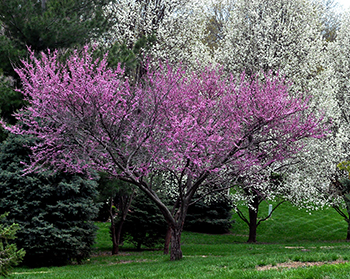Crabgrass Control Success
It's all in the timing
 Did I apply too early? Am I applying too late? Just when do I need to apply crabgrass pre-emergent?
Did I apply too early? Am I applying too late? Just when do I need to apply crabgrass pre-emergent?
Don’t let crabgrass prevention make you crabby. Here’s what you need to know.
What is crabgrass?
Annual grassy weeds germinate, grow and produce seeds each year. They resemble desirable turfgrasses in their growth habit but look different in texture and color. Crabgrass, goosegrass, and foxtail are all annual grasses; crabgrass is the most notorious of these three weeds.
Know the difference between crabgrass herbicides: pre-emergence vs preventers
Crabgrass pre-emergence herbicides prevent annual grass seeds from growing into mature plants. They don’t prevent the seed from germinating; instead, once germinated the plant takes up the herbicide and dies.
Crabgrass preventers are just that — preventers. With the exception of a few products, they will not affect established crabgrass plants.
When to apply crabgrass products in Kansas City
Crabgrass typically begins to germinate around May 1. Apply the herbicide several weeks before germination to allow time for the active ingredient in the herbicide to evenly disperse in the soil. Your exact application date will depend on whether you choose a short residual or a long residual product.
Pre-emergence herbicides are short residual products that don’t last forever. Microorganisms and natural processes break them down. Therefore, if applied too early they may lose much of their strength by the time they are needed.
Short residual preventers are only effective up to 60 days. A second application is often necessary to extend control. These include Halts (Pendimethalin), Team (Benefin + Trifluralin) and Tupersan (Siduron). Typically, a good target date for applying these products is April 15. This gives the active ingredient time to evenly disperse in the soil before crabgrass germination starts. Water in all pre-emergence products with a half inch or more of water within three days after application.
Chemicals for season long crabgrass control
Dimension (Dithiopyr) and Barricade (Prodiamine) are products which will give season-long control of crabgrass from a single application. In fact, they can be applied much earlier than short residual products and still will have sufficient strength to last the entire season. Barricade can even be applied in the fall for crabgrass control the following spring. Dimension can be applied now. This application flexibility makes these products favorites of lawn care companies who have many customers to service in the spring.
Though Dimension cannot be applied as early as Barricade, it is the herbicide of choice if you must apply later than recommended. It is the exception to the rule that pre-emergence herbicides do not kill existing weeds. Dimension can kill crabgrass as long as it is young (two- to three-leaf stage). A good target date for these products is mid-March through mid-April.
 Timing of application is key to success
Timing of application is key to success
Have you been told to apply crabgrass pre-emergence when the forsythia is in bloom? Weather varies from one spring to the next, and with it, the timing of crabgrass germination.
It is often better to time your application to the blooming of the redbud trees. Redbud is that little tree that blooms pinkish-purple each spring, is native and is accustomed to the yearly changes in weather. When the redbud is approaching full bloom, apply short residual crabgrass pre-emergence products.
A follow-up application may be needed about six weeks later to prevent any late germinating weeds from establishing. Longer lasting products have a bigger application window from mid-March through mid-April, or later. As always, read the product label thoroughly and follow all instructions.
Now is your chance to stop crabgrass in its tracks by being prepared and applying the right product at the right time.
Have questions? The Garden Hotline is staffed by trained EMG volunteers and Extension staff who will assist you with questions.
Phone: (913) 715-7050
Email: garden.help@jocogov.org